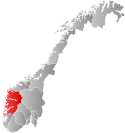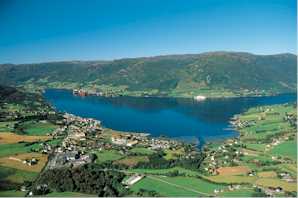
Ølen is a former municipality in the Vestlandet region of Norway. The municipality existed from 1916 until 2006, and originally it was a part of Hordaland county, but in 2002 it was transferred to Rogaland county prior to its dissolution in 2006. The 181-square-kilometre (70 sq mi) municipality was located on the south side of the Bjoafjorden and east of the Ålfjorden. The administrative center of Ølen was the village of Ølensjøen. The municipality of Ølen makes up the northern part of the present-day Vindafjord Municipality in Rogaland county.

Nord-Aurdal is a municipality in Innlandet county, Norway. It is located in the traditional district of Valdres. The administrative centre of the municipality is the town Fagernes. Other urban centres in Nord-Aurdal include the villages of Aurdal, Leira, and Skrautvål. The municipality is served by Fagernes Airport, Leirin. In Nord-Aurdal, there is an alpine skiing center called Valdres Alpinsenter.
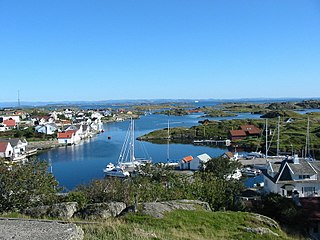
Kvitsøy is an island municipality in Rogaland county, Norway. At only 6.29-square-kilometre (2.43 sq mi), it is the smallest municipality in Norway by area and one of the smallest by population. Kvitsøy is located in the traditional district of Ryfylke. The administrative centre of the municipality is the village of Ydstebøhamn on the island of Kvitsøy. The municipality is an archipelago located at the entrance to the large Boknafjorden. It sits about 2 nautical miles northwest of the mainland Stavanger peninsula.
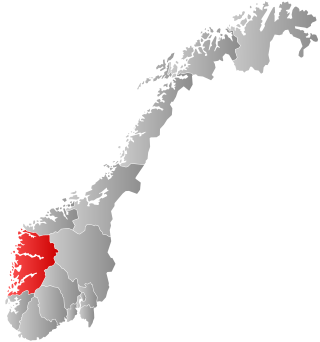
Etne is a municipality in Vestland county, Norway. It is located in the traditional district of Sunnhordland, although it is also sometimes considered to be part of the district of Haugaland. The administrative centre of the municipality is the village of Etnesjøen. Other villages in the municipality include Skånevik and Fjæra. The two largest villages in the municipality are Etnesjøen with 1,159 residents and Skånevik with 594 residents.

Stord is a municipality in Vestland county, Norway. It is located in the traditional district of Sunnhordland. Stord is sometimes called "Norway in miniature" since it has such a variety of landscapes: coastline, fjords, forests, agricultural land, and mountain areas. The administrative centre of the municipality is the town of Leirvik, which is also the largest town in the municipality and the whole region of Sunnhordland. Leirvik was declared a town in 1997. Other population centres in the municipality include the large village of Sagvåg and the smaller villages of Litlabø and Grov.
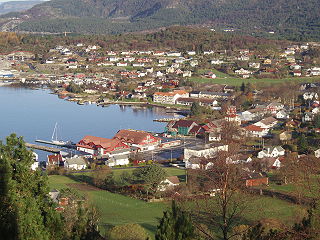
Fitjar is a municipality in Vestland county, Norway. The municipality is located in the traditional district of Sunnhordland. Fitjar municipality includes the northern part of the island of Stord and the hundreds of surrounding islands, mostly to the northwest of the main island. The administrative centre of the municipality is the village of Fitjar.
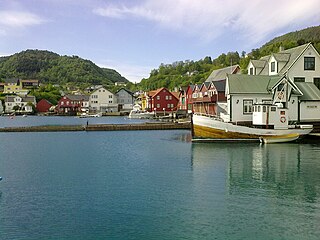
Tysnes is a municipality in Vestland county, Norway. It is located in the traditional district of Sunnhordland. The administrative centre is the village of Uggdal. Other population centres in Tysnes include the villages of Våge and Onarheim. The island municipality is located in a group of islands near the mouth of the Hardangerfjorden. The majority of the municipal population lives on the island of Tysnesøya, the largest island in the municipality.

Kvinnherad is a municipality in Vestland county, Norway. It is located in the traditional district of Sunnhordland, along the Hardangerfjorden. The municipality was the 5th in size in former Hordaland county.
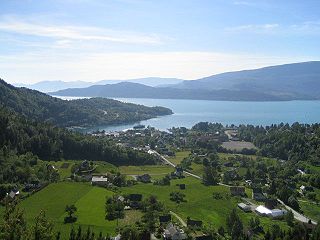
Jondal is a former municipality in the old Hordaland county, Norway. The 247-square-kilometre (95 sq mi) municipality existed from 1863 until its dissolution in 2020 when it became part of Ullensvang Municipality in Vestland county. It was located on the Folgefonna peninsula in the Hardanger district, on the eastern shore of the Hardangerfjorden. The administrative centre of the municipality was the village of Jondal. Other villages in Jondal include Herand, Kysnesstranda, and Torsnes.

Kvam is a municipality in Vestland county, Norway. The municipality is located along the Hardangerfjorden in the traditional district of Hardanger. The administrative centre of the municipality is the village of Norheimsund. Other larger settlements in the municipality include Øystese, Bru, Ålvik, Tørvikbygd, Omastranda, and Mundheim. Historically, the municipality was named Vikør.

Samnanger is a municipality in the Midhordland region of Vestland county, Norway. The administrative centre of the municipality is the village of Tysse. Other main villages in the municipality include Haga and Bjørkheim in Nordbygda. The municipality is located about 20 kilometres (12 mi) east of the city of Bergen, Norway's second largest city. It surrounds the inner part of the Samnangerfjorden and the surrounding valleys. There are mountains that surround the municipality. The development of hydroelectric power plants started here in 1909.

Lindås is a former municipality in the Nordhordland district in the old Hordaland county, Norway. It existed from 1838 until its dissolution on 1 January 2020 when it was merged into the new Alver Municipality. The administrative centre of the municipality was the village of Knarvik, located in the southwestern part of the municipality. Other notable villages in the municipality included Alversund, Isdalstø, Lindås, Ostereidet, and Seim. The Mongstad industrial area in extreme northern Lindås has one of the largest oil refineries and largest seaports in Norway. The oil refinery at Mongstad is by far the largest employer in the municipality.

Masfjorden is a municipality in the central part of Vestland county in Norway. The municipality is located in the Nordhordland district of the county. The administrative centre of the municipality is the village of Masfjordnes. Other villages in the municipality include Frøyset, Hosteland, Matre, and Solheim.

is a municipality in Møre og Romsdal county, Norway. It is part of the Sunnmøre region of Western Norway. The administrative centre of the municipality is the village of Ørsta. Other villages in the municipality include Hovdebygda, Flåskjer, Liadal, Urke, Barstadvik, Åmdalen, Follestaddalen, Nordre Vartdal, Vartdal, Sæbø, Sætre, Store-Standal, and Ytre Standal.
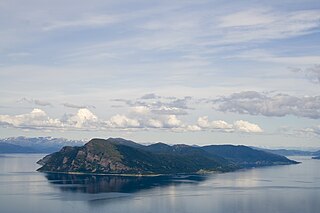
Dyrøy is a municipality in Troms county, Norway. The administrative centre of the municipality is the village of Brøstadbotn. Other villages include Dyrøyhamn, Espenes, Holm, and Hundstrand.

Aure is a municipality in Møre og Romsdal county, Norway. It is part of the region of Nordmøre. The administrative centre is the village of Aure. Other villages in Aure include Gullstein, Stemshaug, Todalen, Tjeldbergodden, Arasvika, and Tømmervåg. Aure has one of the largest wooden churches in Norway, Aure Church.
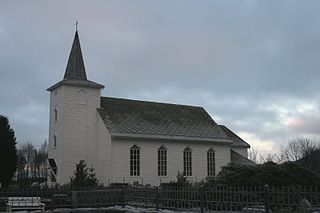
Valestrand is a former municipality in the old Hordaland county, Norway. The 59-square-kilometre (23 sq mi) municipality existed from 1868 until its dissolution in 1964. It was located on a peninsula on the southern shore of the Bømlafjorden inside the present-day municipality of Sveio. The administrative centre of Valestrand was the village of Valevåg. The two churches in Valestrand were Valen Chapel and Valestrand Church.

Hamar Municipality is a municipality in Innlandet county, Norway. It is located in the traditional district of Hedemarken. The administrative centre of the municipality is the town of Hamar. Other settlements in Hamar include Hjellum, Slemsrud, Ridabu, Ingeberg, and Ilseng.

Vikebygd is a former municipality in the old Hordaland county, Norway. The municipality existed from 1902 until its dissolution in 1964. It was located along the eastern and western shores of the Ålfjorden, a small branch off the main Hardangerfjorden. The 102-square-kilometre (39 sq mi) municipality is located in the present-day municipalities of Sveio and in Vindafjord. The administrative centre of the municipality was the village of Vikebygd, where Vikebygd Church is located.
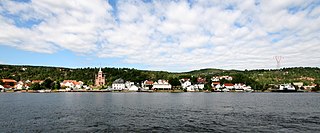
is a former municipality in Vestfold county, Norway. The 58-square-kilometre (22 sq mi) municipality existed from 1845 until its dissolution in 2020. The area is now part of Drammen Municipality in Buskerud county. The administrative centre was the town of Svelvik. The other population centres in Svelvik included Nesbygda and Berger.

